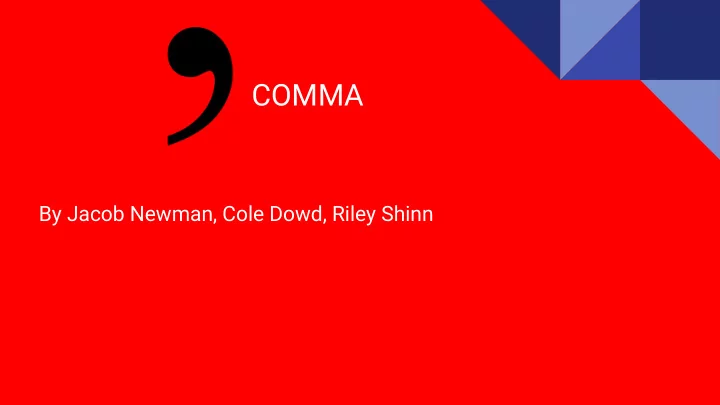

COMMA By Jacob Newman, Cole Dowd, Riley Shinn
There is 13 ways to use a comma 1. Use a comma before any coordinating conjunction (and, but, for, or, nor, so, yet) that links two independent clauses. Example: "I went running, and I saw a duck." 2. Use a comma after a dependent clause that starts a sentence. Example: "When I went running, I saw a duck." 3. Use commas to offset appositives from the rest of the sentence. Appositives act as synonym for a word or phrase. For example, "While running, I saw a mallard, a kind of duck." "A kind of duck" is the appositive, which gives more information about "a mallard."
4. Use commas to separate items in a series. For example, "I saw a duck, a magician, and a liquor store when I went running." 5. Use a comma after introductory adverbs. "Finally, I went running." "Unsurprisingly, I saw a duck when I went running." 6. Use a comma when attributing quotes. The rule for where the comma goes, however, depends on where attribution comes. If attribution comes before the quote, place the comma outside the quotations marks. The runner said, "I saw a duck." If attribution comes after the quote, put the comma inside the quotation marks. "I saw a duck," said the runner.
7. Use a comma to separate each element in an address. Also use a comma after a city-state combination within a sentence. "I work at 257 Park Ave. South, New York, N.Y. 10010." 8. Also use a comma to separate the elements in a full date (weekday, month and day, and year). Also separate a combination of those elements from the rest of the sentence with commas. " March 15, 2016, was a strange day." Even if you add a weekday, keep the comma after "2016." 9. Use a comma when the first word of the sentence is freestanding "yes" or "no." "Yes, I saw a fox when I went running." 10. Use a comma when directly addressing someone or something in a sentence. My boss often asks, "Max, is that done yet?"
11. Use a comma between two adjectives that modify the same noun. For example: "I saw the big, mean duck when I went running." 12. Use a comma to offset negation in a sentence. For example: "I saw a duck, not a baby seal, when I went running." In this case, you still need the comma if the negation occurs at the end of the sentence. "I saw a baby seal, not a duck." 13. Use commas before every sequence of three numbers when writing a number larger than 999. (Two exceptions are writing years and house numbers.) For example, 10,580 or 1,374,180.
Ciatations http://www.businessinsider.com/a-guide-to-proper-comma-use-2013-9
Recommend
More recommend